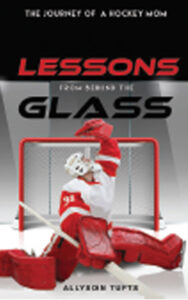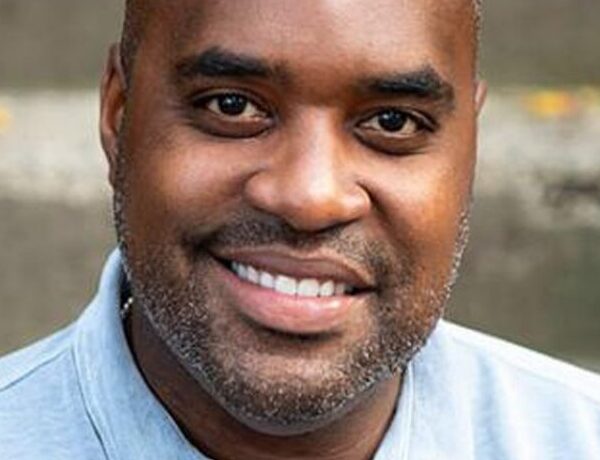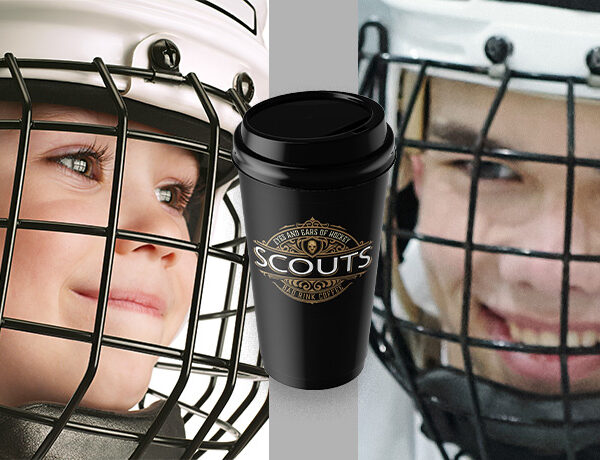What kind of hockey mom are you?
I’m a hockey mom. I really don’t like the label because of some of the ways hockey moms are portrayed in the media as comical characters. Some of those portrayals come from those “over the top” moms of real life, but most of us aren’t like that.
When my child started hockey I didn’t know what to expect. My early experience was one of 6 a.m. practices and nursing my Tim’s coffee while shivering in the stands. I didn’t really see the different mom types until the second season. I started out as the Momma Bear kind of mom. My daughter, at age 5, needed help with gear, encouragement to participate and to wipe her frustrated tears. I helped in the change room and stood by the boards when she sat on the ice and wouldn’t get up. Already involved in figure skating lessons she was a relatively good skater but she was so frustrated at not being able the use her stick properly I thought she would quit after one season.
Season Two was SO different. She was confident and determined. No longer did I have to help with her gear, as she needed only her skates to be tied. So once laces were done, I joined some other parents in the stands and learned the hierarchy of hockey moms.
Some hockey moms are amazing, some are scary, but they all love their kids exactly the same amount. For fun, let’s take a look at some of the different breeds of hockey moms you may encounter.
The Mama Bear
Somewhat overprotective, this mom fiercely protects their player. Often their kid starts off by needing a little extra help. Maybe they started the sport before they were ready and as such their kid needs more attention. Sometimes their kid is a bit smaller than the rest and gets hurt a lot. Sometimes they have special needs or medical conditions. This mom hovers too much. She carries the hockey bag, wipes their tears and basically babies them. Most Mama Bear moms outgrow this behaviour as their kid becomes more competent. If they are still like this by the time their kid is a tween, then their player is probably mortified.
The Supermodel
I was so envious of this mom in my early hockey mom days. She shows up in those killer high heeled boots and gorgeous coat. Her hair and makeup are perfect. Her nails are freshly done and it is obvious that she doesn’t tie skates. She jauntily wears a scarf in team colours tied expertly around her neck. She has a thermal Yeti mug with contents purchased from an upscale coffee shop on the way to the rink. Even her rink blanket looks designer. She gets sideway glances of appreciation from the hockey dads and some worried stares from moms. She is sometimes the subject of gossip as to who she might be trying to influence. But in reality she sacrificed an extra hour of sleep to look this good. This is a lot of work to attend hockey practices. She is likely a somewhat new hockey mom feeling insecure. Either that or she just raced to the rink from work.
The Gossip Columnist
This mom knows the 411 on everyone and everything to do with your hockey association. She is the first to welcome new moms. The Gossip Columnist can find out the scoop on the new player and their parents, siblings, grandparents in minutes. Anything juicy that you share with her will be whispered to the nearest person before your butt hits the bleacher seats. She will spread gossip to anyone who will listen. This is usually done whispered and with over-the-shoulder checks. These words sometimes include backhanded compliments. Who is she talking about? It will be a player, parent, coach or anybody who is deemed a threat to their child’s success on the team. They love to comment on the coaching strategy, including which players are being favoured and which players don’t deserve to be there. They are usually the parent of a player who is middle-of-the-pack in terms of skill. They are genuinely worried that their player will be cut and will do what they can to prevent it.
Hint: When they try to gossip with you it is best to smile, nod, then excuse yourself to go to get something from the car.
The Athlete Supporter
This mom shows up to the rink with her game face on. She thinks her kid is the best no matter what their skill level. She wearing team colors and carries a supersized coffee. She has visions of her child in the big leagues, but knows that this is as good as it might get so she’s living it to the fullest. She has sat in freezing cold ice rinks so much that she knows where all the Tim’s are in a 15km radius of every arena. She eats rink food and her waistline may show a slight expansion from poutine and gravy. She wears a toque to cover the hair she hasn’t had time to wash. She proudly wears a shirt that says “hockey mom, don’t puck with me” but is too much of a sweetheart to live up to the saying.
She is at every game, tournament and practice. She can be a bit much sometimes but you know her heart is in the right place. She has a compliment for every kid as they come off the ice.
The Agent
She actually has no doubt that her kid is going to play in the NHL. Don’t dare question it. She was already scouting out scholarships in the U7 years. She treats her child like a project and she is going to succeed at all costs. Her child does extra training outside of the regular team practises. They have shot coaches, fitness coaches and a strict diet that include questionable pre-game protein shakes. Hockey is a year round, 24/7 activity. She seeks out the best teams, coaches and training she can find. The kid has the best equipment, a rink in their backyard and plastic ice in their driveway. This mom acts like she cares about the team’s success but really only sees the team as a vehicle to aid her superstar. If the team is winning, then her kid is doing well, and the coach is amazing. If the team is losing and her kid is doing well, then the teammates aren’t pulling their weight. If the team is struggling and her player is losing ice time, then the coach is an idiot. They will offer advice as to what the team needs in the form of concerns. Most coaches learn to deal with the Agent early. The Agent’s child is often under a lot of pressure and smart coaches are quick to act as a buffer between the child and parental expectations.
The Social Director
You need one of these moms on every team. They are often the manager or team trainer. They help out in the dressing rooms. They fundraise for team, plan social events, team dinners, order uniforms, plan hotels and outings at tournaments. Coaches love them as they help the team function smoothly. They are always recruiting for volunteers to help out their latest event. They are friendly to all but always busy flitting from one group of people to the next. Their enthusiasm is infectious. At tournaments, they will be wherever the party is … heck they probably organized it. They will make sure all are invited. However, they can be overly involved and always seem to be hitting you up for funds or volunteer time.
The Critic
This mom is never happy. They complain about the weather, traffic, parking, rink food, how long it took to get there and the temperature of the arena. Ask them about their day and you’ll hear how busy they are, how works sucks, how the time of the game is ridiculous, how hungry they are, how cold they are. No matter the positive spin you offer, they find some flaw. They have opinions on the coaching strategy, lineups, how much ice the coaches’ kid is getting and the how bad the refs are. She will be found in the stands with the gossip Columnist and the Agent who enjoy bellyaching as well.
The Phantom
On every team there is a kid whose parents never seem to be there. The player is dropped at the door of the arena as mom drives off in her SUV. Where is Mom going? There are many reasons this mom may disappear. The top reason is time management. Often she is off to another rink to drop off or pick another kid before racing back to get their player. They may be off to get groceries while their child practices. They may be in the car, at a nearby coffee shop or in a quiet corner of the arena working. Some sneak off to the gym or run an errand. But if you watch, you’ll see them reappear at game time. They may only see one period, but they make sure to see enough so their child knows they are there.
The Guard
This mom stands sentry by the boards away from the mom pack. She says little more than a passing greeting to the other moms. Her expression is unreadable. She keeps to herself and avoids the group whenever she can. Why? Is she shy? Doesn’t like people? Nope …more likely is she is being cautious. She is typically a veteran hockey mom who has been around enough in her time and has seen all the rink politics. Her child may have been cut from a team, perhaps unfairly and she isn’t going to risk being a parent cut. She will listen while you talk but prefers not to socialize much.
The Loud Mouth
You hear them before you see them. They are loud in the hall. They are loud in the stands. They yell at everything. If their kid is on a breakaway, block your ears or risk going deaf. They carry a cowbell or a horn but their voice doesn’t need accompaniment. Their battle cry is “Go, go, go”, “Shoooooot”, or “Ref, what was that call?”. They love hockey and love watching their kids play. They cheer on every kid on the ice but really go nuts when their player has the puck. Every game is like a championship game. They yell at refs, opposing parents, and coaches from the stands. They are not above a brawl in the stands if provoked. They usually sit with the Athlete Supporters.
The Mother Goose
This mom arrives at the rink with an entourage of kids. All are younger than their player. One is usually in a stroller. She carries a bag full of snacks and toys to entertain her crew but is not above buying a tub of popcorn or cotton candy to get her goslings to sit still. Her kids run around the rink with little supervision while Mom tries to socialize and watch the game. This is her big outing for the week. She is quick to sneak some “me time” when an older sibling of another player watches her young charges while she watches the game. Often once the game is done she rounds up her crew and they head off to another venue where one of the younger goslings has an activity.
The Squad
This group of moms travel in a pack. Usually a group of 3 or 4, they are friends beyond the rink. They hockey together, vacation together, drink together and school committee together. Their kids have been friends since early hockey and their kids have been on the same team every year since. They take care of each other’s kids. At least one of their husbands are part of the coaching team to help ensure this dynamic continues as long as their kids are playing hockey. They are friendly, welcoming but also keep a close eye on who they let into their little squad. They feel entitled to their kids’ positions on the team and protect it fiercely.
The Goalie Mom
This is a mom with nerves of steel. Their baby is standing in the net while pucks fly at their head. The game’s outcome often relies on how well their player does. She arrives at the rink a little early as her player has extra gear and wants to make sure her child has dressing room space. She is adept at pulling straps on goalie pads tight. She wear pants in which she can kneel on the floor. During the game, if the teams has two goalies, the goalie moms sit together. They understand each other. They worry about their goalie getting hurt as players rush the net. They worry about their kids mental health when the team is down by five goals. They hold their breath during sudden death and shootouts. And during it all they have the calm demeanour of a yoga teacher.
The Quiet Superhero
This is the hockey mom all of us moms should aspire too. Smart and genuine, you know exactly what you are getting with this mom. They may not love hockey but they have a kid who does, so they support their child’s passion. If their child chose to be a figure skater tomorrow, they would support them in that too. They learn about the sport in order to support their player. They reinforce what the coaches are teaching. They never undermine the coaches authority. They fundraise when asked, make potluck contributions and pay fees on time. They never put any pressure on their child. They cheer enthusiastically for every play and every player. They even clap for the other team when they make a great play. They are always positive and nice to every other mom type…even the ones they don’t like.
What kind mom am I now? I’m a crossbreed. I aspire to Quiet Superhero, have moments of Athlete Supporter. I find myself often sitting in the stands with The Squad but I’m not one of them. In reality, I feel most hockey mom are a mix of several types rather than the stereotype extremes portrayed above.
Now excuse me, I have to run to the car … the Gossip is heading my way.
The post What Kind of Hockey Mom Are You? appeared first on Elite Level Hockey.






